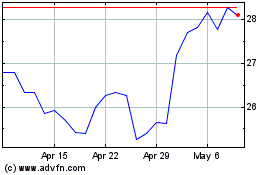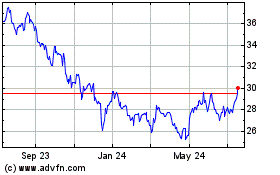Arvinas, Inc. (Nasdaq: ARVN) today announced initial results from
the Phase 2 cohort expansion portion (VERITAC) of a phase 1/2 study
with ARV-471, a novel PROTAC® estrogen receptor (ER) protein
degrader. ARV-471 is being co-developed with Pfizer Inc. (NYSE:
PFE) for the treatment of patients with locally advanced or
metastatic ER positive / human epidermal growth factor receptor 2
(HER2) negative (ER+/HER2-) breast cancer.
This disclosure was originally planned for December 8, 2022.
However, on November 21, 2022, the 2022 San Antonio Breast Cancer
Symposium (SABCS) incorrectly published the abstract, omitting a
key safety data table, and inadvertently released the corresponding
full data presentation on the SABCS website. These full data are
scheduled to be presented on December 8, 2022 at 9:00 a.m. CT in an
oral presentation titled “ARV-471, a PROTAC® estrogen receptor (ER)
degrader in advanced ER-positive/human epidermal growth factor
receptor 2 (HER2)-negative breast cancer: phase 2 expansion
(VERITAC) of a phase 1/2 study.”
As a result of the early release of the full data presentation,
Arvinas will host a conference call and webcast today, November 22,
2022, at 4:30 p.m. ET to discuss these data. Those wishing to
examine the data in more detail are welcome to access our 8K filed
last evening located here.
In the VERITAC trial, ARV-471 shows a favorable tolerability
profile and demonstrates a clinical benefit rate of 38% (total
n=71) (CBR: rate of confirmed complete response, confirmed partial
response, or stable disease > 24 weeks), the primary endpoint in
the trial. These results are consistent with the Phase 1 portion of
this trial.
Patients in VERITAC had a median of four lines of prior
therapies, in a population where 100% of patients were treated with
prior cyclin-dependent kinase (CDK4/6) inhibitors, 79% with prior
fulvestrant, and 73% with prior chemotherapy.
At the time of data cutoff (June 6, 2022), ARV-471 administered
at 200 mg (n=35) and 500 mg (n=36) demonstrated:
- Antitumor activity in 100% CDK4/6
inhibitor-pretreated patients, as measured by a CBR of 38% (total
n=71) in all patients and 51.2% in patients with mutant ESR1 tumors
(n=41).
- Preliminary median progression-free
survival (mPFS) of 3.7 months, a key secondary endpoint, in all
evaluable patients and 5.7 months in patients with mutant ESR1
tumors (n=41).
- A favorable tolerability profile,
with the majority of treatment-related adverse events (TRAEs)
reported as Grade 1 or 2.
“I’m gratified to see the continued differentiated profile of
ARV-471 and its potential to become an important new standard of
care for patients with ER+/HER2- breast cancer,” said John Houston,
Ph.D., President and Chief Executive Officer at Arvinas. “The
positive VERITAC results, in a heavily pre-treated population in
which 100% of the patients received at least one prior CDK4/6
inhibitor and many who had progressed on or after chemotherapy, and
fulvestrant, reinforce our confidence in ARV-471 as we prepare to
initiate two pivotal trials, with the goal of working to give
patients and physicians a potential new option in the fight against
breast cancer.”
“These data validate the early data which led us to enter into
the collaboration with Arvinas and give us the confidence needed to
initiate two Phase 3 registrational trials," said Chris Boshoff,
M.D., Ph.D., Chief Development Officer, Oncology and Rare Disease,
Pfizer Global Product Development.
ARV-471 Clinical Update
Study Design
VERITAC is the Phase 2 cohort expansion portion of a Phase 1/2
single-arm trial of ARV-471 alone and in combination with
palbociclib in patients with ER+/HER2- locally advanced or
metastatic breast cancer (mBC) (NCT04072952). In VERITAC, patients
were treated with either 200 mg or 500 mg ARV-471 with a primary
endpoint of CBR (CR, PR or SD > 24 weeks). Secondary endpoints
include ORR, DOR, PFS and OS as well as safety (AEs) and
pharmacokinetics.
Enrollment
As of the data cut-off date of June 6, 2022, 71 patients with
locally advanced or metastatic ER+/HER2- breast cancer in the
VERITAC expansion cohort were treated once-daily with oral doses of
ARV-471 at 200 mg (n=35) or 500 mg (n=36).
- 100% of patients were previously
treated with CDK 4/6 inhibitors
- 79% of patients were previously
treated with fulvestrant
- 73% of patients were previously
treated with chemotherapy
- 45% received chemotherapy in the
metastatic setting
Efficacy Data
Clinical benefit rate (the primary endpoint,
defined as a confirmed complete response, partial response, or
stable disease ≥ 24 weeks) in all patients (n=71) and in patients
with tumors harboring ESR1 mutations (n=41):
- All patients (200 mg and 500 mg, n=71): 38%
- Patients with tumors harboring ESR1 mutations (n=41):
51.2%
- Patients with ESR1 wild-type tumors (n=25): 20%
- All patients at 200 mg (n=35): 37.1%
- Patients with tumors harboring ESR1 mutations (n=19): 47%
- All patients at 500 mg (n=36): 39%
- Patients with tumors harboring ESR1 mutations (n=22): 55%
Progression free survival
- All patients receiving 200 mg or 500 mg qd ARV-471 (n=71):
median 3.7 months
- Patients with mutant ESR1 tumors (n=41): median 5.7 months
- Patients receiving 200 mg qd ARV-471 (n=35): median 3.5 months
- Patients with mutant ESR1 tumors (n=19): median 5.5 months
- At the time of the data cutoff, data for 500 mg cohort were
immature and therefore not included in a separate analysis
Safety Data
ARV-471 was well tolerated across both dose levels. TRAEs were
primarily Grade 1 and 2, with 5 patients experiencing Grade 3/4
TRAEs:
- 200 mg cohort:
- Grade 1 (n=13): 37%
- Grade 2 (n=13): 37%
- Grade 3 or 4 (n=2): 6%
- Grade 3/4 TRAEs in the 200 mg cohort were Grade 3 QT prolonged
(n=1) and Grade 3 thrombocytopenia and Grade 4 hyperbilirubinemia
(n=1).
- 500 mg cohort:
- Grade 1 (n=11): 31%
- Grade 2 (n=9): 25%
- Grade 3 or 4 (n=3): 8%
- Grade 3/4 TRAEs in the 500 mg cohort were Grade 3 fatigue
(n=1), Grade 3 decreased appetite (n=1), and Grade 3 neutropenia
(n=1).
There was 1 discontinuation due to a treatment-emergent adverse
event (TEAE) and no dose reductions in the 200 mg cohort. There
were 2 discontinuations and 3 dose reductions in the 500 mg
cohort.
Anticipated 2022/2023 Milestones
- Initiate a Phase 3 trial (First
Subject First Visit) with ARV-471 as a second-line treatment in
patients with ER+/HER2- metastatic breast cancer (4Q 2022).
- Initiate a Phase 3 trial (First
Subject First Visit) with ARV-471 in combination with palbociclib
as a first-line treatment in patients with ER+/HER2- metastatic
breast cancer (1Q 2023).
- Initiate the first two cohorts
(First Subject First Visit) and initiate additional arms with other
targeted therapies in the ongoing Phase 1b combination trial
(TACTIVE-U) (2023).
- Present data from the Phase 1b
combination trial with palbociclib (Part C of the Phase 1/2 trial)
at a medical conference (1H 2023).
Investor Call & Webcast Details
A conference call and webcast will be held at 4:30 p.m. ET on
Tuesday, November 22, 2022, with executives from Arvinas and Chris
Boshoff, M.D., Ph.D., Chief Development Officer, Oncology and Rare
Disease, Pfizer Global Product Development. Participants are
invited to listen by going to the Events and Presentation section
under the Investor page on the Arvinas website at www.arvinas.com.
A replay of the webcast will be archived on the Arvinas website
following the presentation.
About ARV-471
ARV-471 is an investigational, orally-bioavailable PROTAC®
protein degrader designed to specifically target and degrade the
estrogen receptor (ER) for the treatment of patients with locally
advanced or metastatic ER+/HER2- breast cancer.
In preclinical studies, ARV-471 demonstrated near-complete ER
degradation in tumor cells, induced robust tumor shrinkage when
dosed as a single agent in multiple ER-driven xenograft models, and
showed superior anti-tumor activity when compared to a standard of
care agent, fulvestrant, both as a single agent and in combination
with a CDK4/6 inhibitor. In July 2021, Arvinas announced a global
collaboration with Pfizer for the co-development and
co-commercialization of ARV-471; Arvinas and Pfizer will equally
share worldwide development costs, commercialization expenses, and
profits.
About ArvinasArvinas is a clinical-stage
biotechnology company dedicated to improving the lives of patients
suffering from debilitating and life-threatening diseases through
the discovery, development, and commercialization of therapies that
degrade disease-causing proteins. Arvinas uses its proprietary
PROTAC® Discovery Engine platform to engineer proteolysis
targeting chimeras, or PROTAC® targeted protein degraders,
that are designed to harness the body’s own natural protein
disposal system to selectively and efficiently degrade and remove
disease-causing proteins. In addition to its robust preclinical
pipeline of PROTAC® protein degraders against validated and
“undruggable” targets, the company has three investigational
clinical-stage programs: bavdegalutamide (ARV-110) and ARV-766 for
the treatment of men with metastatic castration-resistant prostate
cancer; and ARV-471 for the treatment of patients with locally
advanced or metastatic ER+/HER2- breast cancer. For more
information, visit www.arvinas.com.
Forward-Looking StatementsThis press release
contains forward-looking statements within the meaning of The
Private Securities Litigation Reform Act of 1995 that involve
substantial risks and uncertainties, including statements regarding
the potential for ARV-471 to become a new standard of care for
patients with ER+/HER-2 breast cancer; the timing of our and Pfizer
Inc.’s (“Pfizer”) plans to initiate two Phase 3 trials with
ARV-471, one in combination with palbociclib, and additional arms
with other targeted therapies in the ongoing Phase 1b combination
trial (TACTIVE-U); and the timing of our and Pfizer’s plans to
present data from the Phase 1b combination trial with palbociclib.
All statements, other than statements of historical facts,
contained in this press release, including statements regarding our
strategy, future operations, future financial position, future
revenues, projected costs, prospects, plans and objectives of
management, are forward-looking statements. The words “anticipate,”
“believe,” “estimate,” “expect,” “intend,” “may,” “might,” “plan,”
“predict,” “project,” “target,” “potential,” “will,” “would,”
“could,” “should,” “continue,” and similar expressions are intended
to identify forward-looking statements, although not all
forward-looking statements contain these identifying words.
We may not actually achieve the plans, intentions or
expectations disclosed in our forward-looking statements, and you
should not place undue reliance on our forward-looking statements.
Actual results or events could differ materially from the plans,
intentions and expectations disclosed in the forward-looking
statements we make as a result of various risks and uncertainties,
including but not limited to: our and Pfizer performance of our
respective obligations with respect to our collaboration with
Pfizer; whether we and Pfizer will be able to successfully conduct
and complete clinical development for ARV-471; whether we obtain
marketing approval for and commercialize ARV-471 on our current
timelines or at all; whether our cash and cash equivalent
resources will be sufficient to fund our foreseeable and
unforeseeable operating expenses and capital expenditure
requirements; and other important factors discussed in the “Risk
Factors” section of our Annual Report on Form 10-K for the year
ended December 31, 2021 and subsequent other reports on file with
the U.S. Securities and Exchange Commission. The forward-looking
statements contained in this press release reflect our current
views with respect to future events, and we assume no obligation to
update any forward-looking statements except as required by
applicable law. These forward-looking statements should not be
relied upon as representing our views as of any date subsequent to
the date of this release.
Arvinas Contacts
Investors:Jeff Boyle+1 (347)
247-5089Jeff.Boyle@arvinas.com
Media:Kirsten Owens+1 (203)
584-0307Kirsten.Owens@arvinas.com
Pfizer (NYSE:PFE)
Historical Stock Chart
From Apr 2024 to May 2024

Pfizer (NYSE:PFE)
Historical Stock Chart
From May 2023 to May 2024
